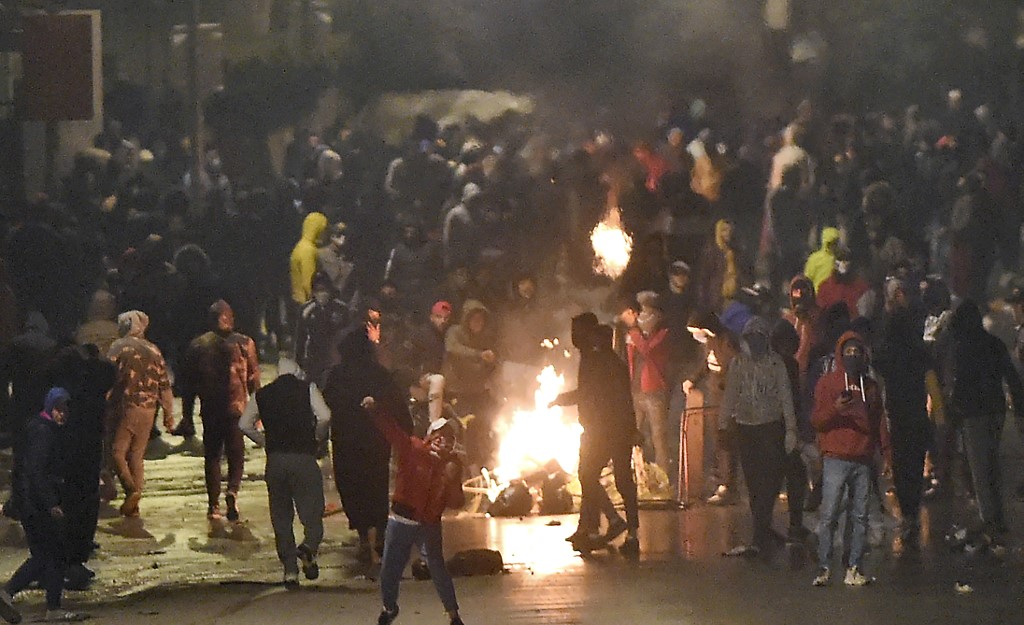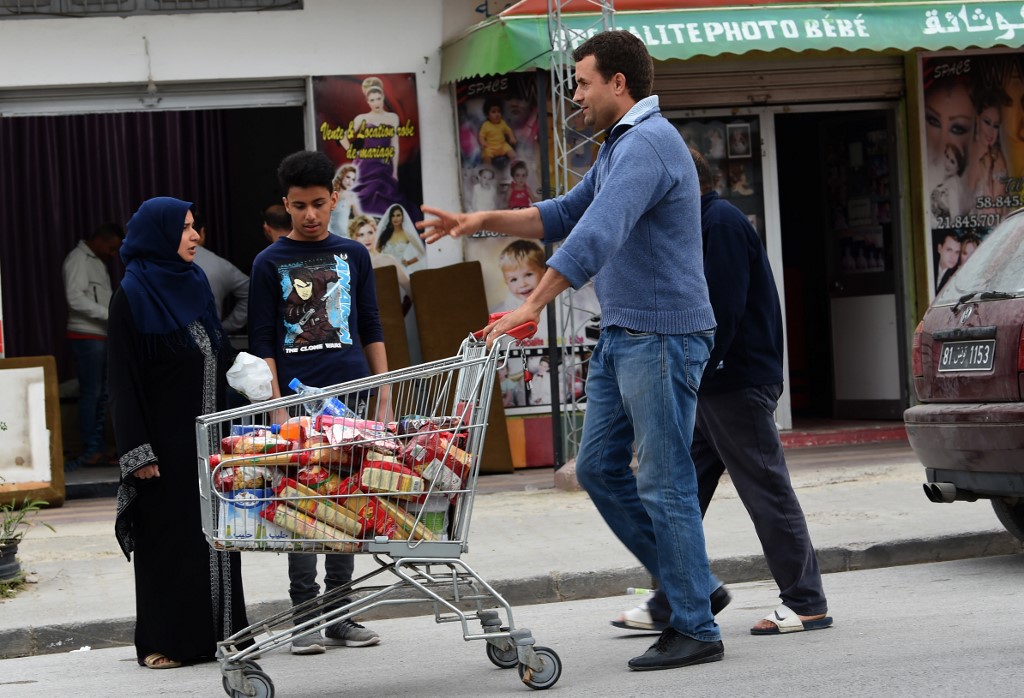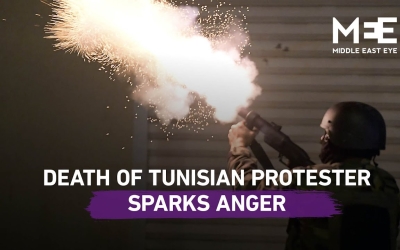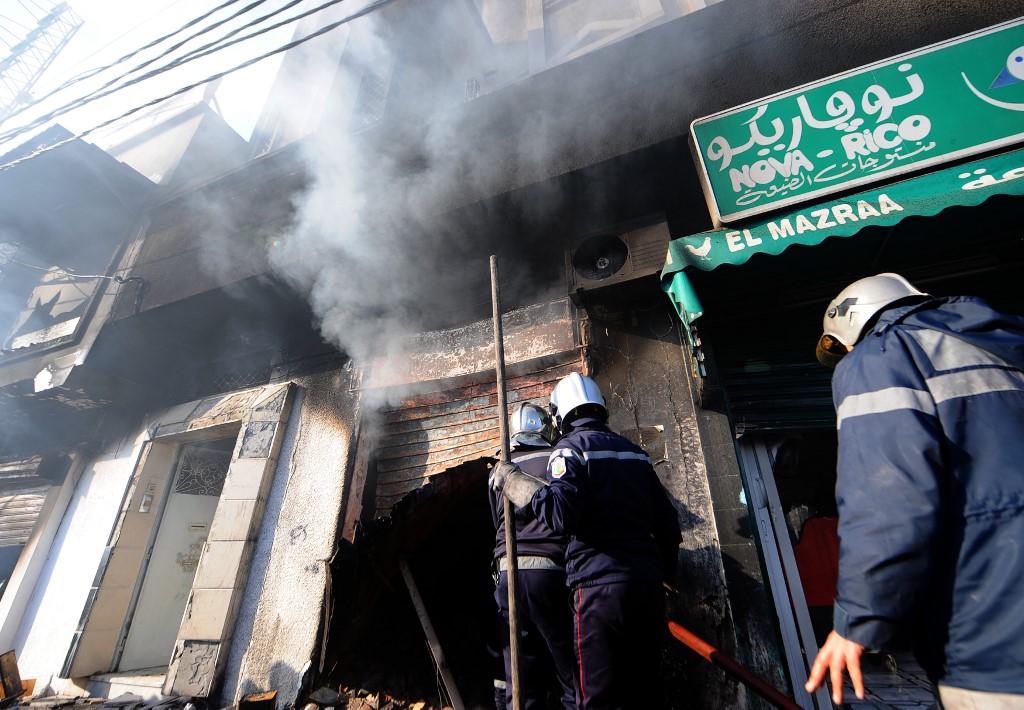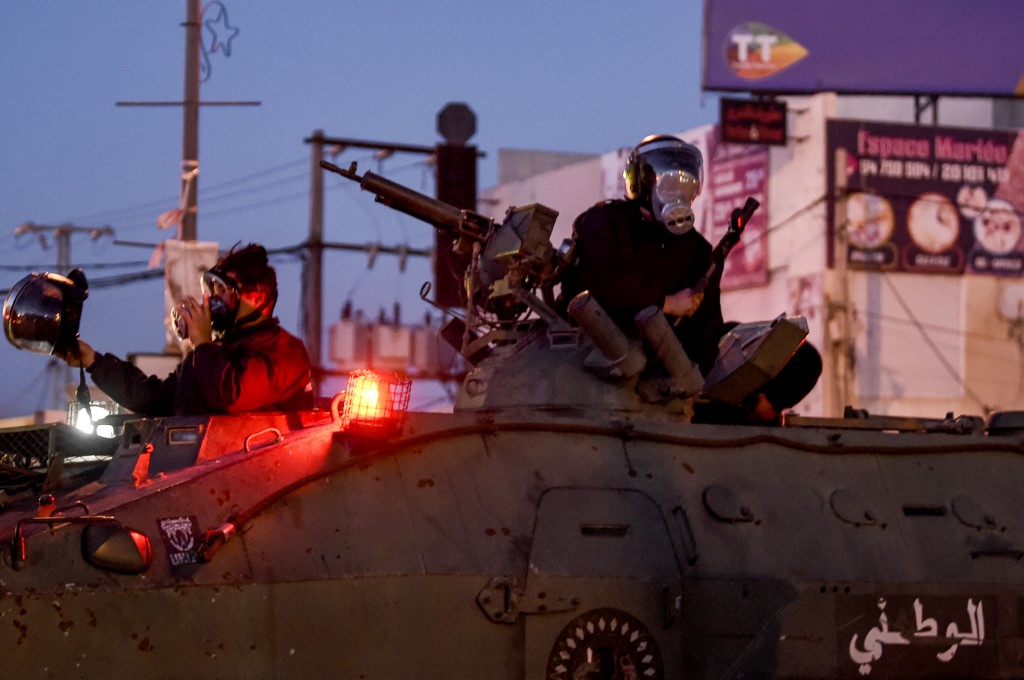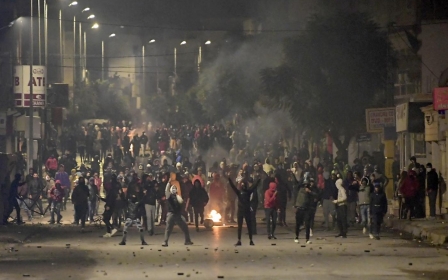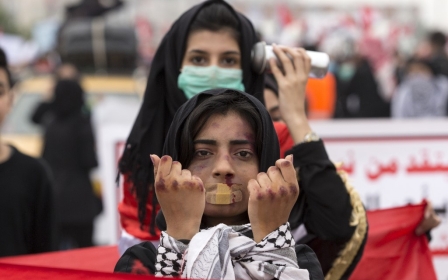Tunisia protests: A night of tear gas and anger in a deprived Tunis suburb
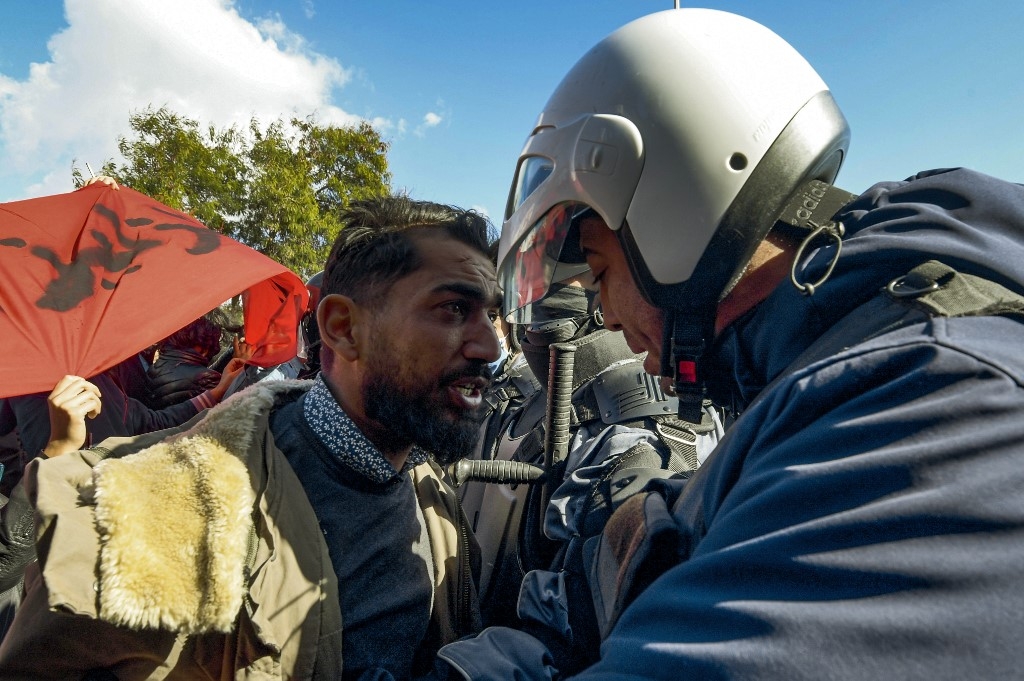
“Barra rawah!” - go home! - barks a man in uniform armed with a teargas grenade launcher. Anyone who doesn’t instantly turn on their heels becomes a target.
The policeman makes his way down Ibn Khaldoun Avenue alongside a slow-moving police van. It’s a little after 4pm, and Tunis is under curfew.
'The revolution has not changed anything. It's even worse when it comes to the working classes'
- Jbel Lahmar resident
On Sunday 17 January, with darkness yet to fall, the shops of Ettadhamen, a working-class suburb west of the capital, remained shuttered while security forces pushed people down side streets of the main thoroughfare.
The curfew had been brought in three days prior, on the tenth anniversary of the ousting of longstanding ruler Zine el-Abidine Ben Ali, officially to stop the spread of the Covid-19 pandemic rampant nationwide.
Channelled by the police, the human tide regroups a little further away. “You see what they’re doing? Even here in our own neighbourhood they come for us!” says an angry teenager.
New MEE newsletter: Jerusalem Dispatch
Sign up to get the latest insights and analysis on Israel-Palestine, alongside Turkey Unpacked and other MEE newsletters
A few metres away, a shopkeeper hands a customer their change: “Yesterday, I could smell the gas all the way home, even upstairs,” she says.
The housing estate of Ettadhamen was the scene of a night of clashes between mainly young Tunisians and security forces.
Most Tunisian media depicted the protesters as "petty criminals" and "hooligans", a perception shared by much of public opinion - while others see the movement as a popular uprising.
‘People want the dissolution of parliament!’
The town of Ettadhamen has 84,000 inhabitants in an area a little over three square kilometres. In this old neighbourhood, an informal settlement that was gradually swallowed up by the town. Public services have never quite caught up.
Infrastructure is substandard. Every major downpour brings the fear of flooding. Ibn Khaldoun Avenue is the area’s crippled economic backbone, featuring a few shops, cafes, fast-food outlets, grocery stores, a supermarket and a post office.
A network of narrow streets thread through the town like blood vessels, forming a dense urban network where a single cartridge of tear gas can choke dozens of houses.
Suddenly, a loud noise rings out and a white cloud floats above Ettadhamen. Neighbours meet hastily. There are dozens of people, some young, others with children and families.
A man of about 30 harangues the crowd: “We can’t take any more of these politicians! Parliament must be dissolved!” Gunfire intensifies.
Two teenagers drag a tyre into the middle of the road, douse it in petrol and set it on fire.
Night falls in Tunis, and already several roadblocks are aflame, glowing red and orange, to prevent the entry of the security forces. But they only offer paltry protection against the National Guard armoured tanks sent as back-up for the half-dozen police vans already in place.
Tanks are the ultimate public order weapon: oblivious to the stones pelted at them, they can get right up to the protesters. Stationed just in front, four policemen launch tear gas grenades into the general area of District 105, where the majority of the protesters are gathered.
Doors slam. People struggle to breathe. "H" is terrified. Her children, a boy of ten and a little girl of six, come into the family studio, their eyes swollen from tear gas and crying.
The tiny room serves all purposes: sitting room, bedroom. The fridge is next to the bed. The toilet, which has no flush, and the kitchen are on the landing.
Outside, the acrid smell slowly fades. Doors and windows are reopened. Residents set about resupplying the protesters: bottles of water thrown from the first floor of a house. Cola and milk are in high demand for rinsing eyes.
Unemployment and poverty
Two hours before curfew, the situation had been calm. On that gloomy Sunday, the wind howled along Avenue Ibn Khaldoun where a semblance of normal life continued amid the city-wide lockdown.
Some youngsters gathered at the roadside: “I haven’t even got 200 millimes ($0.07) to buy a cigarette,” one of them jokes.
Here, they can laugh at their own misery, because everyone is in the same boat and all share a common daily goal: to get some dinars.
According to the National Institute of Statistics (INS), the zone has one of the highest levels of poverty in Greater Tunis, despite this region having the highest national concentration of wealth.
The social divide is dramatic - two worlds living side by side, destined never to meet.
At 26 years old, M is on the wrong side of that divide. Sporting dark glasses and a shaved head, he’s an unemployed sports teacher who “does what he has to do” to make ends meet.
He shares the same grievances as the protesters, but he didn’t want to join them. The same goes for his friend, S, who was once a member of the national wrestling squad.
He too stayed home, he told MEE: “Personally, I don’t agree with the protests. If I want to claim my rights, I’m not going to go out smashing stuff… I can do it legally. By law you’re allowed to protest peacefully. Plus, the way I see it, you have to protest during the daytime, because no one’s going to listen to you at night.”
In working-class neighbourhoods, the celebrations marking the anniversary of the revolution sometimes involve clashes with the police. This 14 January, the lockdown confined everyone at home. But will it be enough to keep the lid on this anger?
Protests across the country
The closure of the country, a total lockdown and curfew from 4pm onwards and the widespread police crackdown in the days following the first protests have together instilled the movement with unprecedented magnitude.
This may explain how spontaneous protests broke out simultaneously in several deprived suburbs of Tunis, such as Ettadhamen, Kram-Ouest, Douar Hicher, Sidi Hassine and Kabbariya.
Meanwhile, across the country, Bizerte, Sfax, Sousse, Kairouan, Kasserine, Siliana and other towns saw similar uprisings. Local contexts may vary, but the grievances are always the same: unemployment and poverty.
The suffering endured in recent years due to a long-term economic crisis have been exacerbated by the pandemic.
Misery is compounded by social exclusion and alleged recurring police discrimination.
"This has always been a problem here in Jbel Lahmar," a young man from the working-class neighbourhood close to the city centre, tells MEE. He remembers once being stopped by the police. "The officer asked me where I was going, I told him I was going home to Jbel Lahmar after classes. He asked me what I was studying."
When he heard the answer, the policeman burst out laughing: "An architect, in Jbel Lahmar?”
This young man actually refused to join in the protest, avowing his rejection of "such actions", but did criticise the "provocations" of the security forces.
"The way they treat Tunisian citizens is not good and the revolution has not changed anything. It's even worse when it comes to the working classes. With the residents of the more upmarket neighbourhoods, the police can't try anything.”
The ‘grizzly bear’
The call to prayer ends, and the cries of the crowd can be heard again in the distance. On Sunday evening in Ettadhamen, in between police onslaughts, J agrees to answer our questions.
At 33, he is one of the oldest protesters. A contact sports professional, he speaks almost entirely in soundbites.
"We are the poorest, we are the hardest hit. You know, if you don't work, if you don't come out on top at the end of the day, you don’t eat,” he said.
“We have collections to raise a little money to help out someone who’s sick, for example. A neighbour was injured the other day and we managed to raise 50 dinars (around $18.60) to pay for his treatment. "
Dressed in a tracksuit, red trainers and with a neatly trimmed beard, he still remembers the uprising that led to the fall of Ben Ali in 2011.
Ettadhamen saw a particularly large crowd of protesters at the time.
"What you’re seeing here is another revolution, for the poor and the hungry,” J says. “We are still fighting the system because the system has not changed. "
'Look at this marginalised youth, even if they protest for two years, three years or even twenty years, nobody is ever going to be interested in them'
- L, a protester
But this time, he says, freedom is no longer one of the demands: “This is what it has come to. We just want to be able to work and eat.”
According to J the police are afraid of Ettadhamen, nicknamed “the dragon” and “the grizzly bear”: "When it awakens, you’d better watch out!" he exclaims, as he surveys the security forces deployed in his neighbourhood.
"Two tanks, a water cannon, all these police officers," it makes him feel proud that his town sees this level of deployment unlike anywhere else in the country.
He wore the national colours during international sports competitions, "but Tunisia has given me nothing, nothing at all".
Many feel disregarded, like L, who is putting on a pair of trainers to join the protesters.
“Look at this marginalised youth, even if they protest for two years, three years or even twenty years, nobody is ever going to be interested in them. As long as the rich live well, we poor people don't count.”
With his black hair slicked back and his thick, round glasses giving him a bookish look, L is critical of police violence.
"We didn't do anything, we're in our neighbourhood and they're coming to gas us. The other day, a tear gas grenade landed on our porch. The truth is, whether you live or die, it doesn't change anything for them.”
That Sunday evening, in Ettadhamen, the stage is set for repression. The police charge at regular intervals, with a frontline of armoured vehicles. They advance up the avenue to disperse the youth, who flee like a flock of sparrows.
‘The truth is, whether you live or die, it doesn't change anything for them’
- L, a protester
As they pass by each side street where demonstrators have taken refuge, the police fire tear gas canisters. They launch them over houses, banking on the element of surprise, as well as horizontally, at head height. Spent cartridges lie scattered over the road.
Some of them still carry the name of the manufacturer - a Spanish company called Falken - as well as the type of ammunition. These are 37/38 mm grenades.
Fired at close range, they can cause serious injury and even death, according to the Omega Research Foundation, an independent UK organisation that provides research on security technologies.
This type of weapon should only be fired from a height rather than at point-blank range, explains the French League for Human Rights in one of its reports on a Yellow Vests demonstration in Montpellier.
Failure to adhere to these measures is said to have led to the death of a young man in Sbeitla, in central Tunisia. Haykel Rachdi's death was announced on 25 January. According to his family, he was hit in the head by a tear gas canister during a nighttime rally a week earlier. An investigation has been opened.
The police, ‘Tunisians, just like us’
In the suburbs of Tunis, the first injuries are quick to appear. A teenager shows off a large red bruise on his collarbone, another lifts his trouser leg to reveal his calf swollen to double its size.
But there are also more serious cases, like the dazed man struggling to breathe after inhaling tear gas. He has to lean on someone to walk. He was hit on the cheekbone by a tear gas canister, two centimetres from his eye and is bleeding from his nose and mouth.
Dozens of tear gas grenades are fired that evening by the police. Shortly before 7pm, a crowd of several hundred young people gather on Ibn Khaldoun Avenue. Three hours later, the police leave the area. There are some celebratory shouts, but soon they bid each other goodnight as small groups make their way peacefully from the scene: “See you tomorrow, it’s time for bed.”
Everyone returns to their homes, like well-disciplined supporters at the end of a football match. On Sunday 17 January, no shops or public buildings were targeted by protesters in Ettadhamen.
When protesters tried to prise open some metal shutters on a shop, others intervened. "Fortunately, they reasoned with us," says A, a young artist who stopped working because of the pandemic.
"It's better this way. I was thinking of taking something that I could have sold for 50 dinars, but they did well to call us to order. We were ashamed of ourselves, we apologised.”
Some are trying to guide the movement in the right direction and to prevent it from descending into violence, like J, one of the oldest. The goal is not to injure the police, he said. “They are Tunisians, just like us, but they have to pay for what the government has done.”
Some demonstrators are armed with sabres. They use the long, impressive blades to try to puncture the tyres of the armoured vehicles. Molotov cocktails are used only very occasionally that evening. More often than not, protesters avoid contact, throwing stones from afar.
By the time of publication, protests have already ceased almost everywhere across Tunisia. The brutal crackdown partly explains the stifling of the movement.
Since it started, at least 1,200 people have been arrested, 30 percent of them minors, according to the Tunisian League for Human Rights on 25 January. Several NGOs have criticised the "campaigns of arbitrary arrests" and "excessive use of force".
*Names have been omitted for security reasons
The article is a translation of a story originally published by Middle East Eye's French website.
Middle East Eye delivers independent and unrivalled coverage and analysis of the Middle East, North Africa and beyond. To learn more about republishing this content and the associated fees, please fill out this form. More about MEE can be found here.


